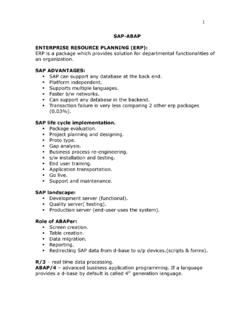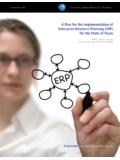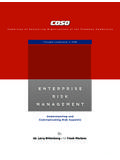Transcription of The Royal Bank of Scotland - Social Enterprise …
1 The Royal Bankof ScotlandForewordSocial enterprises are difficult. They challenge the accepted ways of doing things. It's notthat they set out to be awkward, but having discovered better, more sustainable ways totackle some of the most pressing Social , economic and environmental issues facing ustoday, it's hard to accept the status quo. As the chief executive of one of the UK's fastestgrowing Social enterprises said, There is more to us than we know and once you have seenit and experienced it you will never settle for anything less.' However this characteristic makes Social enterprises problematic for those agencies andorganisations that are expected to provide appropriate advice, support and finance to helpthem succeed in meeting their objectives. Conventional business those trading to makemoney for their owners and investors broadly get what they need, but Social enterprises those in the business of regenerating a community blighted by poverty, or providingemployment for those who would normally be considered unable to work, or delivering alocal public service don't.
2 This situation needs to change. The Royal Bank of Scotland and NatWest have been working pragmatically with policy-makers and the sector to encourage a more favourable environment for Social enterprisesto 'do business'. We have also been working in a number of practical ways to ensure socialenterprises have the appropriate tools to develop, grow and improve their collaboration with Forth Sector is one such initiative. This planning guide is very much about helping the sector to help itself. But it is also atool the bank will be able to use to learn more about the sector. It should also go someway to fostering improved communications between the bank and the sector, which willinevitably lead to a better, more attentive service. Tracy Betts Head of Social Economy Banking The Royal Bank of Scotland & NatWest 1 Contents PagePageIntroductionWho Is The Guide For?2 What Is Social Enterprise ?2 How To Use This Guide?2 Who Has Developed the Guide3 The Business Development Process for Social Enterprise3 STEP 1 MOTIVATIONO verview7 Motivation7 What Is Your Motivation?
3 7 What Motivates Your Organisation?7Do You Have The Passion?8Do You Have a Potential Business Idea?9 What Do You Know About Social Enterprise ?9 Summary10 STEP 2 PREPARATIONO verview11 Preparation Stage11 Self Assessment11 Stakeholder Analysis12 Risk Assessment12 The Balance of Aims13 Business Failure14 Summary15 STEP 3 IDEA EVALUATIONO verview17 Idea Evaluation17 Idea Generation17 Options Appraisal21 External Market Forces22 Summary23 STEP 4 TESTING YOUR IDEAO verview25 Testing Your Idea25 Research26 Reality Check27 Summary27 PageSTEP 5 EXPLORATIONO verview29 Exploration29 Feasibility Study29In-Depth Market Research29 Competitors30 The So What? Question30 The Why Not? Question30 Location, Location, Location30 Pricing The Product or Service31 Making Sense of the Market31 Promoting Your Product or Service32 Social Aims32 Briefing a Consultant33 How Feasible is the Idea?33 Summary34 STEP 6 BUSINESS PLANNINGO verview35 Business Planning36 The Business Plan37 Critical Success Factors37 Marketing37 Promotional Mix37 Financial Planning38 Operating Budgets and Cashflow Forecast38 Scenario Planning38 Investment Finance38 Getting the Best Advice39 Writing the Plan39 Summary41 STEP 7 START-UPOverview43 Start Up43 Top Tips For Successful Start Up43 Summary43 APPENDICESC ontacts ListIResource SectionIIBusiness Plan TemplateIIIR eferencesIVAcknowledgementsVIntroduction WHO IS THE GUIDE FOR?
4 This guide will help your organisation to develop a new Social the guide is focused on helping voluntary organisations to develop new Social enterprisesit will also be useful for: Voluntary organisations that want to transform into Social businesses Geographic or thematic community groups that want to explore whether Social Enterprise is an appropriate way to regenerate or createemployment for their community Groups of people seeking to establish co-operative Social enterprises Individual Social entrepreneurs who are aiming to set up a business for a Social purposeThe guide outlines a step-by-step approach to starting up your Social Enterprise and focuses on the key issues surrounding businessdevelopment. The guide assumes a fundamental knowledge of business planning . It recognises that there is a wealth of existing good material tosupport business planning . It focuses on the specific issues around Social Enterprise guide may also be a good management tool for any community group, voluntary organisation or project based Social entrepreneur in termsof business planning where the aim is to generate significant income from trading or commercial Social Entrepreneur/sAlthough the guide focuses on how organisations should develop Social enterprises we recognise that an individual (or occasionally a small group)drives this development process.
5 These Social entrepreneurs are catalysts for change within organisations. They drive forward Social enterprisedevelopment. The guide has been developed to support these catalyst Social entrepreneurs. If you fall within this category you will find that some of theinformation in the guide is directed at you as an individual, whereas other aspects outline areas that need to be considered by your also recognise that we can offer no more than general information or guidance. In seeking to develop your Social Enterprise youwill bebringing to the equation a whole series of personal experiences, skills and attributes. The culture, aspiration, resources, size, capacity and previousexperience of your organisation will also influence how you develop your Social Enterprise . WHAT IS A Social Enterprise ?A Social Enterprise is a business that trades for a Social Social aims of the business are of equalimportance to its commercialactivities and this combination is often referred to as the double bottom line.
6 A Social Enterprise focuseson generating income through thesale of goods and services to a market or through commercial Enterprise is a different way of doing business. It is at the heart of the Social economy. The added value of Social enterprises comes fromthe way in which they use profit to maximise Social , community or environmental benefits. The Social Enterprise sector is both vibrant you are unfamiliar with Social Enterprise , the Resource section within the guide provides details on where to find out more TO USE THIS GUIDED eveloping a Social Enterprise , like starting any new business, is an exciting and active process. It involves a lot of hard work but equally itshould be a rewarding and enjoyable guide is designed to help you move through the process of developing your Social Enterprise . It will help you create a business plan thatdescribes what you intend to do. Our aim for the guide is that it is a self-help toolfor you and your guide is designed as a reference for you.
7 It should be referred to as you are developing your Social Enterprise rather than being readfrom cover to cover in one may be that as you move through the process of developing your Social Enterprise you identify that you needadditional support or training. We have signposted (*) this in the Resource Section and Contacts List at the back of the a business plan is important if you are looking for either development/investment finance and/or support to start your Social a business plan is also important to act as a route map and reference to ensure that your Social Enterprise is growing and developing, asyou want it to. 23To help you develop a Social Enterprise the guide will: Introduce the step-by-step approach to Social Enterprise development. Urge you to think aboutissues as you are planning . Provide you with prompts for things you need to do. Signpost you to additional sources of help and advice in the Resource Section and Contacts Lists.
8 Provide you with some top tips where you see this sign Summarise and identify the key questions you should ask yourself at the end of each chapter. You can use this as a checklist ofthings you need to do before moving to the next is a model business planning templateat the end of the step-by-step guide. This business planning template is one approach towriting your business plan. As you use the step-by-step guide it might be useful to cross-reference with the template and complete therelevant sections. Both Social Enterprise and business planning come with their own jargon and terminology. Where practical we have attempted to explain thejargon throughout the guide. Within the resource and contacts sections of the guide we also signpost (*) you to jargon-busting informationoffered on HAS DEVELOPED THE GUIDE?Forth Sector ( Social Enterprise Development Initiative) and the Royal Bank of Scotland have developed and produced the guide. The guidehas also been part-funded through the ESF Objective 3 the focus of the guide is to assist organisations in Scotland to develop Social enterprises, it is our hope that the guide will beutilised by Social enterprises throughout the UK as a tool for business planning and development.
9 THE BUSINESS DEVELOPMENT PROCESS FOR Social ENTERPRISEI ntroductionForth Sector and Social Firms Scotland started mapping whether there was a business development process for Social Enterprise in 2001. The arrow diagram below outlines a seven-step approach towards developing your Social Enterprise . This approach has been tested and refinedwith over 200 part of the process, Forth Sector also reviewed the business planning guides that existed for mainstream business development. This led toa partnership with the RBS/NatWest Group to develop a guide for Social Enterprise development based on one of their existing businessdevelopment templates. The Social Enterprise Development ProcessThe decision to represent the business development process for Social Enterprise in an arrow diagram was influenced by the idea ofrepresenting moving forward. Developing a Social Enterprise will require you to drive forward towards your destination. The arrow diagram on the next page outlines the seven steps that an organisation has to move through to develop a Social Enterprise .
10 Thesesteps are:1. motivation 2. preparation 3. idea evaluation 4. testing your idea 5. exploration 6. business planning 7. start-upEach step has discrete elements but each step is inter-related. We have taken the key headings from the arrow diagram as the format for theguide. Each of these steps will be explored in more detail in the following chapters. The information from one step should therefore influencethe questions you ask in another part of the process. All of these steps taken together should inform the decisions you eventually make. * >?4 BUSINESS DEVELOPMENT PROCESS FOR Social ENTERPRISEIDEATESTINGBUSINESS MOTIVATIONPREPARATIONEVALUATIONYOUR IDEAEXPLORATIONPLANNINGSTART-UPAWARENESS MOTIVATIONSELFASSESSMENTRISKASSESSMENTST AKEHOLDERANALYSISEXTERNALANALYSISIDEAGEN ERATIONOPTIONSAPPRAISALIDEAFORMATIONFEAS IBILITYSTUDYBUSINESSPLANSTART-UPIDEASTIM ULATIONUNFEASIBLEUNFEASIBLEUNFEASIBLEUNF EASIBLEThe arrow diagram may seem a bit daunting atfirst.







